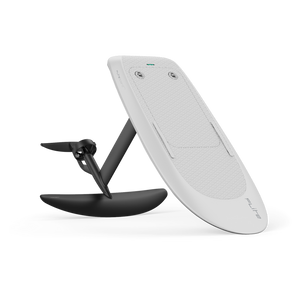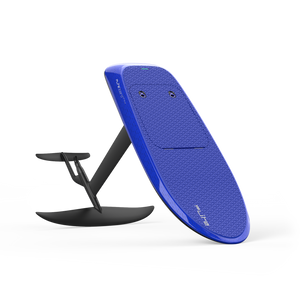How fast do eFoils go?
A comprehensive guide to electric hydrofoil boards
Electric hydrofoil boards, or eFoils, have brought a fresh twist to water sports by offering a unique blend of surfing, kiteboarding, wakeboarding, and snowboarding. With a battery-powered motor and hydrofoil wing that lifts the board above the water, eFoils give riders a smooth and almost silent ride. But just how fast can these innovative boards really go?
According to Fliteboard Founder and CEO David Trewern, "With the right setup, a Fliteboard can reach up to *50 km/h (30mph), but the true joy of eFoiling isn't just in how fast you can go - it's in how effortlessly you can glide over the water and find freedom." Now, let’s explore the factors that influence eFoil speed, and how different elements of the board setup, rider weight and conditions contribute to performance.
What is an eFoil?
An eFoil is an electric-powered surfboard that uses an underwater hydrofoil wing to lift it above the water's surface once it reaches a certain speed. The board is powered by a battery-operated motor, and riders control the speed using a handheld wireless remote. As the board picks up speed, the wing lifts the board out of the water, reducing drag and creating a smooth, flying sensation.
How fast can eFoils go?
On average, most eFoils can reach speeds of 32-48 km/h (20-30 mph). However, the exact speed can vary based on a number of factors, including the motor's power, wing design, board size, and the rider's weight and skill. The maximum speed depends on whether the rider is looking for a cruising experience or a high-speed adrenaline rush. The Fliteboard Foil Time Calculator is an excellent tool to see how different batteries, wings and rider weight can affect speed and duration of an eFoil session.
Factors that affect eFoil speed

Several factors influence how fast an eFoil can go:
1. Thrust
The thrust an eFoil generates is one of the primary determinants of its speed. It is largely a combination of motor power, gearbox and propeller design, but hydrodynamics also play a pivotal role as the lower the drag the more effectively the eFoil can move through the water.
2. Wing Design
The size and shape of the hydrofoil wing significantly affect both speed and stability. In general, larger wings provide more lift at lower speeds, making it easier to foil at slower speeds, which is ideal for beginners. However, larger wings can also limit the top speed. Smaller, more streamlined wings reduce drag, allowing for higher speeds but require more skill to handle, as they offer less lift at lower speeds and are typically less stable. Fliteboard has hosted a number of eFoil race events around the world with most riders choosing the Race 700 wing. Designed by expert hydrodynamicists, it features a streamlined shape to minimize drag whilst maintaining control at high speed.
3. Board Size
Larger boards provide greater stability during take off, planing and touchdown, making them ideal for beginners, but they typically have a lower top speed due to their size and weight. Smaller, more performance-oriented boards, like Fliteboard PRO and ULTRA L2 allow for higher speeds but require more balance and skill from the rider.
4. Rider Weight
Rider weight is another key factor. Lighter riders can reach higher speeds more easily since they require less power to lift the board out of the water. Heavier riders need more power to achieve the same speeds.
5. Water Conditions
Calm, flat water allows for the highest speeds, as there’s less resistance and turbulence. Rougher conditions, like waves or choppy water, create drag and make it harder to maintain high speeds. Wind direction can also impact performance, with headwinds slowing down the eFoil and tailwinds providing a helpful boost. It’s worth checking a reputable website like surf-forecast.com which can let you know conditions of the ocean before you leave the house.
How battery life affects eFoil speed
eFoil batteries typically last between 60-90 minutes, depending on the speed and conditions. Smaller batteries offer less weight and can allow you to reach higher speeds quicker, but they don’t last as long. If you’re looking to maximize your time on the water, cruising at moderate speeds can help slow power consumption.
Beginner vs. Advanced Riders

The speed and setup of an eFoil varies depending on the rider's experience level:
For Beginners
Beginners should start with lower speeds and larger more stable wings for easier control. Most eFoils offer customizable speed settings, allowing riders to gradually increase speed as they gain confidence.
For Advanced Riders
Experienced riders often prefer smaller boards and wings that allow for faster speeds and more agility. Pushing the motor to its limit and using streamlined wings, advanced eFoilers can reach higher speeds and perform more technical maneuvers, such as carving, jumping, and other tricks. These riders may also opt for specialised / specialized eFoils designed for performance and speed like the limited edition Flite x Marc Newson.
eFoil Safety Tips
As with any watersport, safety is a priority when riding an eFoil. Because of the high speeds involved, wearing proper safety gear is essential. Here are some key safety tips:
● Always wear a helmet: Even when not riding at high speeds or performing tricks.
● Use a life jacket or PFD: Even experienced riders should wear a personal flotation device (PFD) to ensure safety in case of falls.
● Be mindful of other water users: Stay a safe distance from swimmers, other watercraft, and obstacles to avoid accidents.
● Know your limits: If you’re a beginner, avoid pushing yourself too hard. Stick to lower speeds and calmer waters until you’re more comfortable on the eFoil.
Conclusion
eFoils offer a thrilling way to experience the water, combining speed, agility, and the sensation of flying above the surface. With top speeds ranging from 32-50 km/h (20-30 mph), and the ability to tailor your board’s setup to your riding style and skill level, eFoiling can be enjoyed by riders of all abilities. If you want to learn how to eFoil or improve your performance at speed, Fliteboard has a number of Fliteschools around the world that you can visit for lessons and pro tips, plus a library of great videos featuring “how to’s” talks with pro riders and eFoil races.









